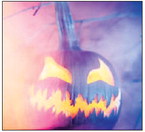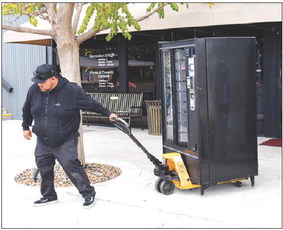From All Hallows Eve to Halloween


by Jim Greer
LW contributor
You may be surprised to learn that one-quarter of all the candy sold in America each year is purchased for Halloween. In fact, Americans spend about $6 billion each year on Halloween, second only to Christmas as the largest commercial holiday. Of course, we who live in Leisure World buy and begin eating our candy as soon as it appears in the stores, knowing full well that no trick-or-treaters will be knocking on our doors.
The fascinating genesis of Halloween is the ancient Celtic festival of Samhain, when bonfires were lit and costumes were worn to ward off ghosts. To the Celts, Nov. 1 was their New Year’s Day, and the lines separating the living and the dead were blurred beginning Oct. 31, when ghosts of the dead returned to earth.
Once the Roman Empire conquered the Celts, two of their festivals—Feralia, the passing of the dead, and the festival honoring Pomona, the goddess of fruits and trees—were merged with the Celt Samhain celebration. The Roman symbol of Pomona, the apple, may very well have been the origin of our tradition of bobbing for apples during fall festivals.
By the 8th century, Pope Gregory III designated Nov. 1 as a day to honor all the Roman Catholic saints. This official designation of All Saints Day also led to the observance of All Hallows Eve, or what we now call Halloween.
Here in the colonies, beliefs and customs of European ethnic groups merged with those of indigenous tribes, creating a uniquely American version of Halloween. Celebrations included “play parties,” public events held to celebrate the harvest, featuring neighbors sharing stories of the dead, the telling of fortunes, dancing and singing.
By the late 1800s, a movement attempted to remake Halloween into a more enlightened community holiday, encouraging festive get-togethers rather than emphasizing ghosts, pranks and witchcraft. The spirit of the movement evidently failed because in the 1890s, the first horror films were produced, and since that time, America has been obsessed with creating and watching some of the most disturbing films imaginable.
According to Dr. Katherine Brownlowe at The Ohio State University College of Medicine, “Some people enjoy the gore, some people like being startled, and some people love the sheer escapism it offers.” People do like the feeling they get when they’re scared. Our brains go into fight-or-flight mode, our hearts race, our muscles tense, and we scream and jump. Dr. Brownlowe continued, “Believe it or not, for some people, this is a lot of fun.”
Perhaps the most universally enjoyed genre of horror films are Frankenstein movies. Since moving pictures began, there have been 73 Frankenstein-themed films. Of course, my favorite is “Young Frankenstein,” directed by Mel Brooks and starring Gene Wilder.
As a parody of Mary Shelley’s book “Frankenstein” and a sendup of the 1931 Frankenstein and 1935 “Bride of Frankenstein” films, “Young Frankenstein” has become a modern comedy revision of the Celtic festival of Samhain. We gather around the modern big screen bonfire, put on scary outfits and watch a latter-day ghost story, laughing at our fears.
As the second Halloween of the pandemic, many will attempt to combine their COVID coping mechanisms with their candy consumption. Jimmy Fallon noted that “a group of wine experts has actually come up with a list of the best wines to pair with Halloween candy. They say white wine goes great with Skittles, red wine goes great with Twix, and... we’re alcoholics, aren’t we?”
Any way you want to celebrate Halloween, enjoy yourself…and your candy!




